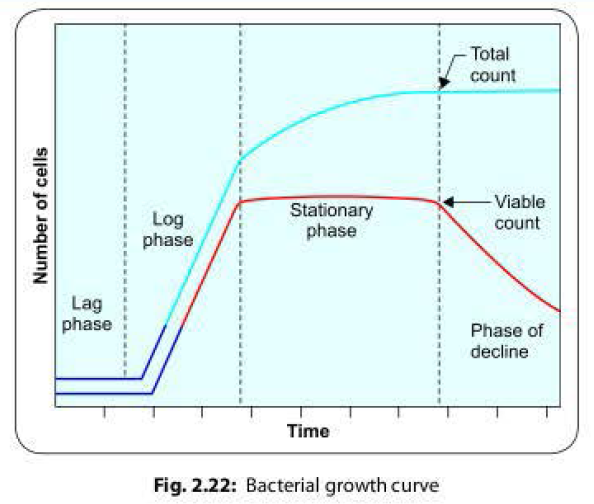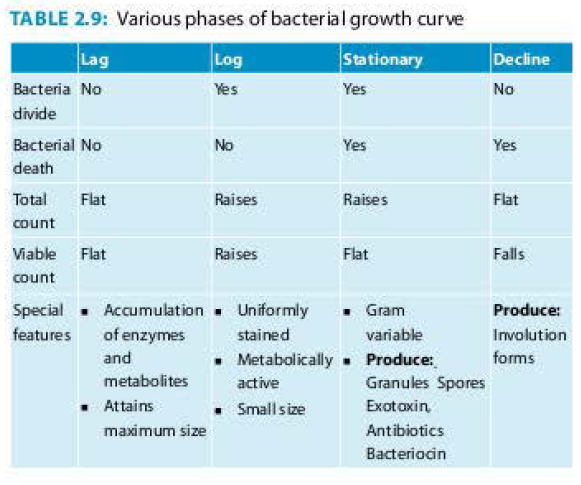Bacterial
growth curve determines bacterial count at different time and comprises of lag
phase, log phase, stationary phase and decline phase
When
a bacterium is inoculated into a suitable liquid culture medium and incubated,
its growth follows a definite course. When bacterial count of such culture is determined
at different intervals and plotted in relation to time, a bacterial growth curve
is obtained comprising of four phases (Fig 2.22, Table 2.9).
1. Lag phase: It is the period between inoculation and beginning of multiplication of bacteria. After inoculating into a culture medium, bacteria do not start multiplying immediately, but take some time to build-up enzymes and metabolites.
· Bacteria increase in size due to accumulation of enzymes and metabolites.
· Bacteria reach their maximum size at the end of lag phase.
2. Log phase: In this phase bacteria divide exponentially so that the growth curve takes a shape of straight line.
At this stage, the bacterium is-
· Smaller in size
· Biochemically active: It is the best stage co perform the biochemical reactions
· Uniformly stained: It is the best time to perform the Gram stain
3. Stationary phase: After the log phase, the bacterial growth ceases almost completely due to exhaustion of nutrients, accumulation of toxic products and autolytic enzymes.
· The number of progeny cells formed is just enough to replace the number of cells that die.
· Hence, the number of viable cells remain stationary as there is almost a balance between the dying cells and the newly formed cells. But the total count keeps rising. In this phase:
§ Bacterium becomes
Gram variable
§ More storage
granules are formed
§ Sporulation
occurs in this phase
§ Bacteria produce
exotoxins, antibiotics and bacteriocins.
4. Decline
phase: Gradually, the bacteria stop dividing completely; while the cell death
continues due to exhaustion of nutrients, and accumulation of toxic products.
• There is decline in viable count and not in total count.
• Involution forms are seen.
Continuous Culture
It is a special type of culture, which supports the
bacterial growth in a particular phase (e.g. log phase) for longer period
continuously without depletion of nutrients or without accumulation of toxic
products.
•
Special devices are used which supply the
replenishing nutrients and remove the dying bacterial cells and their toxic
products.
•
Continuous cultures can be maintained mainly
by two methods.
§ Turbidostat
culture
§ Chemostat
culture
• Continuous culture of bacteria is required sometimes for industrial and research purposes.
FACTORS AFFECTING GROWTH OF BACTERIA
There are several environmental factors that affect the growth
of the bacteria.
Oxygen
On basis of their oxygen requirements, bacteria are
classified as:
• Obligate aerobes: They can grow only in the presence of oxygen (e.g. Pseudomonas, Mycobacterium tuberculosis. Bacillus, Brucella and Nocardia).
• Facultative anaerobes: They are aerobes that can also grow anaerobically (e.g. most of the pathogenic bacteria, e.g. E. coli, S. aureus, etc.).
• Facultative aerobes: They are anaerobes that can also grow aerobically (e.g. Lactobacilluss).
• Micro-aerophilic bacteria: They can grow in the presence of low oxygen tension, i.e. 5%-10% of oxygen ( e.g. Campylobacter and Helicobacter).
• Obligate anaerobes: These bacteria can grow only in absence of oxygen, as oxygen is lethal to them (e.g. Clostridium).
• Aerotolerant anaerobe: They can tolerate oxygen for some time, but do not use it (Clostridiumm histolyticum).
Carbon Dioxide
Organisms that require higher amounts of carbon dioxide (5- 10%) for growth are called capnophilic bacteria. Examples include Brucella abortus, Streptococcus pneumoniae etc.
Temperature
Most of the pathogenic bacteria grow optimally at 37°C (i.e.
human body temperature). However, the optimal temperature range varies with
different bacterial species.
Accordingly bacteria can be grouped into:
· Psychrophiles: These grow best at temperatures below 20°C; example, most of the saprophytes.
· Mesophiles: These grow within a temperature range 25°C and 40°C; example, most of the pathogenic bacteria
· Thermophiles: These bacteria grow at a high temperature range of 55°C- 80'C e.g. Bacillus stearothermophilus.
pH
Most pathogenic bacteria grow between pH 7.2 - pH 7.6. Very few bacteria (e.g. lactobacilli) can grow at acidic pH below - pH 4, while bacteria such as Vibrio cholerae are capable of growing at alkaline pH (8.2-8.9).
Light
Bacteria (except phototrophs) grow well in darkness. They are sensitive to ultraviolet rays and other radiations in light. Photochromogenic mycobacteria produce pigments only on exposure to light.
Osmotic
Effect
Bacteria
are able to withstand a wide range of external osmotic variation because of the
mechanical strength of the cell wall.
· Sudden exposure of bacteria to hypertonic solutions may cause plasmolysis-osmotic withdrawal of water leading to shrinkage of protoplasm. This occurs more readily in gram -negative than in gram-positive bacteria.
· Sudden transfer of bacteria from concentrated solution to distilled water may cause plasmoptysis - excessive osmotic imbibition of water leading to swelling and rupture of the cell.
Mechanical
and Sonic Stresses
Though bacteria have tough cell walls, they may be ruptured and disintegrated by vigorous shaking with glass beads and by exposure to ultrasonic vibrations.
Moisture
and Desiccation
Moisture
is an essential requirement for the growth of bacteria because 80% of the bacterial
cell consists of water. However, the drying has varying effects on different organisms.
· Some organisms like Treponema pallidum and N. gonorrhoeae die quickly after drying, while M. tuberculosis and Staphylococcus aureus may survive drying for several weeks.
· Drying in cold and vacuum (lyophilization) is used for preservation of microorganisms.
Further reading:



Great
ReplyDelete